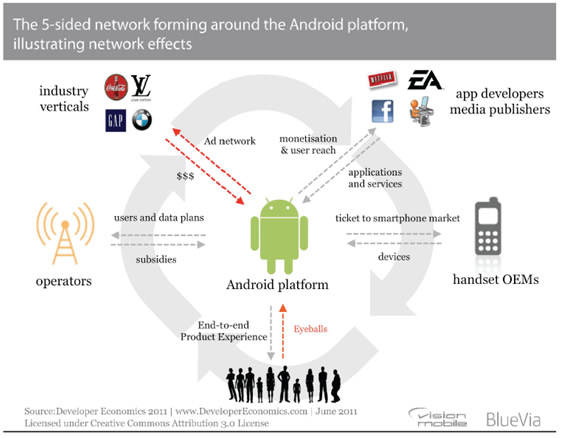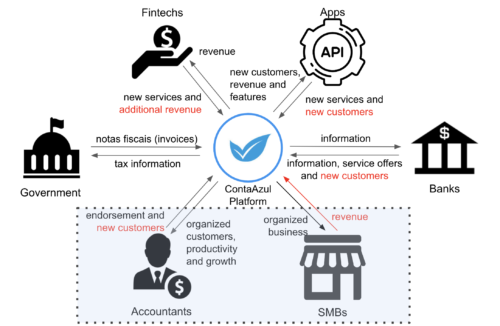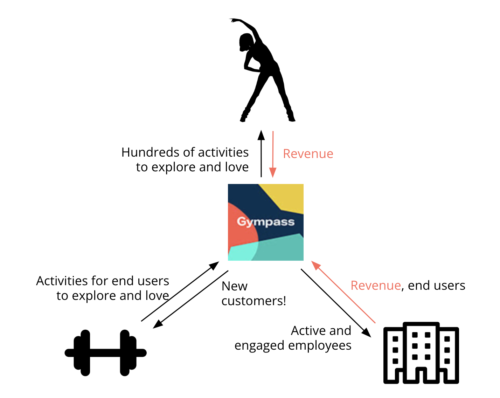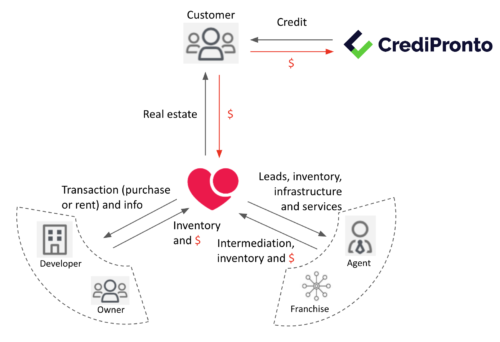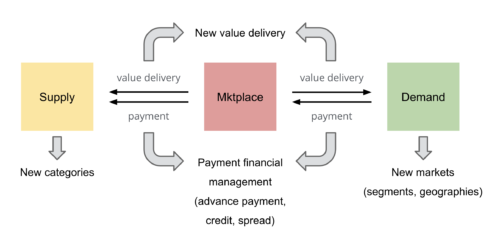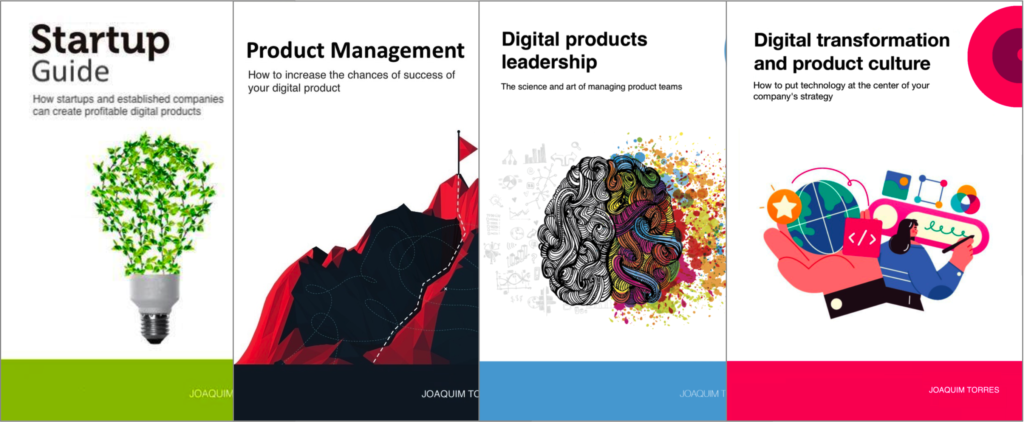
Type of company vs digital maturity
5 de March, 2024
Agile, digital and product culture
20 de March, 2024This article is another excerpt from my newest book “Digital transformation and product culture: How to put technology at the center of your company’s strategy“, which I will also make available here on the blog. So far, I have already published here:
- About the book
- Part 1: Concepts
- Chapter 1: The so-called digital transformation – Project and Product
- Chapter 2: Uncertainty and digital transformation
- Chapter 3: Types of company
- Chapter 4: Type of company vs digital maturity
Let’s now dive into chapter 5, about:
Business models
If you are an entrepreneur or work in the strategy area of a company, you have likely heard about business models. After all, understanding how your company generates value and profit is fundamental for success. However, in an increasingly digital world, the relationship between business models and technology is even more crucial. Therefore, let’s revisit this essential topic and start with the basics: the definition of the term “business model.” Then, we will discover how this understanding is critical for building a successful digital transformation strategy.
Business model
A business model is how an organization creates, delivers and receives value. (Source: Wikipédia).
Understanding how the organization creates, delivers, and receives value requires clarity about to whom the organization creates and delivers value and from whom it receives value. At this point, two well-known terms come into play: B2C (Business-to-Consumer) and B2B (Business-to-Business).
B2C and B2B
B2C stands for Business to Consumer. It is when a company sells a product or provides a service directly to the end customer, to individuals (Private Individuals in legal terminology). Typically, the sales cycle is relatively short, spanning hours or days, depending on the value of the purchase. For example, deciding to buy an ice cream is a much simpler decision than deciding to buy a car or a house. The decision tends to have emotional elements and can be impulsive. Some examples of B2C companies are Netflix, Nubank, N26, and Lopes.
On the other hand, B2B stands for Business to Business, where the customer of the company is another business, or Legal Entity (again in legal terminology). In B2B business models, the purchase decision cycle tends to be longer, spanning months and, in some cases, years. The purchase decision tends to be more rational, based on clear criteria, reaching the point where some companies have clearly defined procurement processes. Examples include Locaweb, Conta Azul, and SAP.
B2B SMB and B2B Enterprise
When looking at B2B business models, it’s necessary to make another distinction: between B2B SMB and B2B Enterprise.
In B2B SMB, products are designed for sale to small businesses. SMB stands for Small and Medium Businesses. Typically, in B2B SMB, there are numerous customers (thousands) paying a small amount, ranging from tens to a few hundred dollars. This scenario shares some similarities with the B2C landscape, as you are building a product or service for many customers. There is little room for customization.
On the other hand, in B2B Enterprise, we are dealing with a few customers (dozens or hundreds) paying a high amount, tens or even hundreds of thousands of dollars.
To illustrate the differences, let’s use the example of Locaweb’s email marketing product. It was focused on small clients. In 2013, we had around 30,000 clients with this product, and these clients sent an average of 0.5 billion messages per month, a typical B2B SMB scenario. However, we often received requests for features typical of large companies that send a large volume of emails. It was a new market opening up for us. We analyzed our options: do nothing, evolve the product, develop a new product to serve this new market or acquire a company that already had a product to serve this new market. We chose the last option and acquired All In, a company with an email marketing product designed for large enterprises.
To give you an idea of the differences, Locaweb’s email marketing product had “only” 400 clients, but these clients sent an average of 3 billion messages per month. The All In email marketing product is clearly an example of B2B Enterprise. With a small number of clients paying a high amount, it is common to receive customization requests. In this scenario, all clients are considered special and require personalized attention, but it’s crucial to be cautious not to implement features that will be used by only one client. On the other hand, requests from a client, especially the larger ones, will always be a priority in this scenario.
Other models
In addition to the B2C, B2B SMB, and B2B Enterprise models, there are other acronyms used to represent different stakeholders:
- B2B2C: Business to business to consumer, where a company serves another company, which, in turn, serves the end consumer. An example is eBay, whose clients are the merchants serving end consumers through eBay.
- B2B2E: Business to business to employee, where a company serves another company, providing benefits and well-being solutions for the employees of that company. This is the business model of both Gympass and Betterfly, companies that sell corporate well-being benefit solutions for companies to offer their employees.
- C2C: Consumer to consumer, where a company facilitates the sale of products or services between end consumers. An example of C2C is etsy, for buying and selling handmade products.
- B2D: Businesstodeveloper,amarketspecificallyfordevelop- ers of websites and applications. Examples include GitHub, AWS (Amazon Web Services), and Locaweb.
An important aspect to note is that some companies may adopt more than one business model, as in the case of Locaweb, which is both B2B (B2B SMB and B2B Enterprise) and B2D.
Another crucial aspect of these business model classifications is that they all aim to help understand the customer and how the product assists in solving a problem and/or meeting a need.
Platforms
Platforms are products that deliver more value as more users use them. This is known as the network effect, based on the number of possible interactions among these users, a quantity governed by the formula n*(n-1)/2, where n is the number of users. Platforms have existed for many years in the offline world. A good example is the markets of antiquity. They are a two-sided platform with buyers on one side and sellers on the other. The more sellers there are, the more useful the market is for buyers, and the more buyers there are, the more attractive the market becomes for sellers.
There are single-sided platforms (Facebook, Instagram, WhatsApp, etc.) and multi-sided platforms, which can be of three types:
- Exchange: involves buyers on one side and sellers on the other. In this type of platform, it’s common for a person to enter as a buyer and be invited to participate as a seller. Who hasn’t been invited to drive for Uber? Besides Uber, other examples include Airbnb and Mercado Livre. Exchange platforms are also known as marketplaces. They are not exclusive to the online world and exist in the offline world, such as shopping centers and street markets, as demonstrated by ancient markets. What happens is that these exchange platforms are greatly enhanced by technology.
- Content: brings together content producers and consumers with advertisers. Content is the focus, and monetization is typically done through advertising. Examples include Facebook, Google, and news portals. Here we can also see that these platforms are not exclusive to the online world. They also exist in the offline world and have been around for a long time, as with broadcast television, magazines, and newspapers.
- Technical: functions like an operating system where, on one side, there are specialists, and on the other, there are users. Android and iOS are good examples, with app developers on one side and users on the other. Conta Azul is another example: on one side there are small business owners, and on the other there are accountants. An offline example here is hospitals, with doctors of different specialties (cardiology, orthopedics, neurology, etc.), law firms with lawyers who deal with in different areas (business law, environmental law, criminal law, labor law, family law, etc.), and fitness centers (with trainers focused on weightlifting, stretching, aerobic exercise, swimming, etc.). An interesting characteristic that differentiates technical platforms from exchange platforms is that on technical platforms, a person cannot switch to the specialist side without investing heavily in education—after all, one cannot become a software developer, an accountant, or a doctor overnight. It requires years of education and training to become a specialist.
Here is an example of a technical platform with 5 sides:
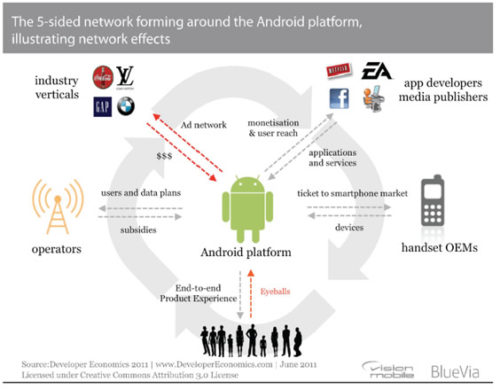 Example of a 5-sided technical platform.
Example of a 5-sided technical platform.
This example makes some crucial points clear:
- Who are the platform actors interacting in the Android platform: users, app developers, device manufacturers, telecom operators, and advertisers.
- The network effect is explicit, as it’s evident that the more each actor uses the Android platform, the better it is for everyone. More users make the Android platform more attractive to operators, device manufacturers, app developers, and advertisers. The presence of more app developers on the platform, resulting in more apps, attracts more users, making it even more appealing to users, operators, device manufacturers, and advertisers, creating a positive feedback loop.
- The value exchange between the platform and each actor is also explicit, showing what each actor receives from the platform and what each actor provides in return. Users receive a comprehensive mobile experience and, in return, provide their attention. App developers deliver applications and services and, in return, receive monetization and access to a large user base.This model was used to map the actors and value exchange of Conta Azul, Gympass, and Lopes.
Conta Azul seen as a platform.
Gympass seen as a platform.
Lopes seen as a platform.
In all these diagrams, it is evident that the greater the participation of each type of actor in the platform, the more beneficial it is for all platform participants. The exchange of value between the company and each of these actors becomes a crucial factor in fostering a thriving ecosystem.
Value exchange map vision
These diagrams serve as a valuable tool for understanding the value exchange map vision and the dynamics of value exchange within a company or business unit. They provide clarity regarding the interlocutors involved in the business model, whether they are individuals or other companies, and highlight how the organization creates, delivers, and receives value in the process.
This visual representation is instrumental in assessing opportunities for applying digital technologies strategically to improve and optimize existing value exchanges within the business.
Marketplaces
Marketplaces are a specific type of platform: they are exchange platforms, and they have very specific dynamics. Marketplaces have three types of elements:
- Supplier: Provides goods or services available for consumption;
- Demand: Individuals or companies that may need the goods or services offered by the supplier;
- Marketplace: Where the demand meets the supplier’s offer, and a transaction occurs.
These three elements relate to each other as follows:
- Value Delivery: The marketplace delivers value to both the demand and the supplier. The value delivered to the supplier is people or businesses interested in their goods or services. The value delivered to the demand is a varied number of suppliers of goods and services.
- Payment: To access the goods and services offered by the suppliers, the demand pays the marketplace, and the marketplace pays the supplier. Typically, the marketplace retains a transaction fee. This fee can be a fixed amount or a percentage of the payment.
Marketplace dynamics.
Let’s analyze Uber as an example. The suppliers are the drivers. The demand comes from the passengers. The marketplace is Uber. Uber delivers new passengers to the drivers and provides transportation services to passengers by offering drivers. Passengers pay Uber, which pays the drivers and retains a fee.
Another example is iFood, a three-sided marketplace where the suppliers are both the restaurants and the drivers who deliver the food to the customer. The demand comes from customers who order food through the iFood app, which acts as the marketplace. iFood delivers demand to restaurants and drivers, offering a food ordering service to its customers. iFood charges the customer and pays the restaurants and drivers, retaining a fee that is part of its revenue. In this case, iFood connects two types of suppliers (restaurants and drivers) to one type of demand (users).
A third example is Gympass, a three-sided marketplace where the suppliers are the gyms, and the demand comes from the companies and their employees. Gympass provides new users to the suppliers while offering a network of gyms that companies can provide as a corporate benefit to their employees. Companies and employees pay a fee to Gympass, which, in turn, pays the gyms. In this case, Gympass connects one type of supplier (gyms) to two interconnected types of demand (companies and their employees).
Expanding the marketplace
If you manage a marketplace and want to expand it, there are several different paths you can take:
- Diversification of demand: you can offer the goods and services of your marketplace to new segments and geographic regions. Uber did this in its international expansion. Uber also extended its transportation services to businesses, in addition to its regular offerings to end-users.
- Diversification of suppliers: You can offer new goods and services to your demand. Uber did this with Uber Eats. Amazon started by offering only books; now, it offers almost everything.
- Delivery of New Value: You can provide new value to your offering and demand. Uber offers many services to its drivers, such as car rentals, car maintenance, phone plans, and health insurance. iFood offers a PoS system to its affiliated restaurants. Mercado Libre, an Argentinean e-commerce platform, offers MercadoShops, an e-commerce website builder, and Becommerce, a back-office management solution, to its sellers who are individuals selling items on its platform.
- Financial Payment Management: As the payment from demand to supplier goes through the marketplace, you can offer financial services to both demand and suppliers, such as advance payment, credit, and managing the spread. iFood, through its app, enables its customers to pay the bill when they are in the restaurant. Uber partnered with Intuit to offer financial management services to its drivers. Mercado Libre provides a payment solution for its sellers and buyers, Mercado Pago; more recently, Mercado Libre decided to offer loans to its sellers in Brazil and Mexico.
The following image illustrates these four types of marketplace expansion:
Possibilities for expanding a marketplace.
These four types of marketplace expansion are not mutually exclu- sive. You can explore all four options simultaneously, but keep in mind that each one can be a new business on its own. Therefore, be careful not to divert resources too much from your existing marketplace business.
In the next chapter, before delving into the topic of Principles that form the basis for the success of a digital transformation, I want to introduce another very important concept, from which the principles derive: It is the concept of Agile, Digital and product culture.
Recommendation
The digital technologies have a direct impact on how a company creates, delivers, and receives value from its customers. Therefore, despite being a well-known topic in business, it is essential to review the concepts of business models to envision the direct impact on decisions regarding the adoption of digital technology in a company.
I suggest conducting an analysis of your company, evaluating its business model, and determining whether platform and marketplace dynamics make sense. Create a trade map view based on the examples shown for Android, Conta Azul, Gympass, and Lopes. From there, you can begin mapping which value exchanges could benefit from the use of digital technologies.
Summing up
- A business model is how an organization creates, delivers, and receives value. It is crucial to have a clear understanding not only of how the organization creates and delivers value but also for whom and from whom it receives value. This understanding of the business model is critical in a digital transformation context as it helps comprehend where digital technologies can have the most impact.
- A common classification of business models is into B2C and B2B. Within B2B, there’s further classification into B2B SMB and B2B Enterprise. Other classifications include B2B2C, B2B2E, C2C, and B2D. These classifications aim to help understand the customer and how the product assists in solving a problem and/or meeting a need.
- Platforms are products that deliver more value as more users utilize the platform, known as the famous network effect. There are single-sided platforms (Instagram, What- sApp) and multi-sided platforms, which can be exchange platforms (Airbnb, Mercado Livre), content platforms (Facebook, Google), or specialist platforms (Android).
- Marketplaces are exchange platforms with three well-defined elements: demand, supplier, and the marketplace.
Workshops, coaching, and advisory services
I’ve been helping companies and their leaders (CPOs, heads of product, CTOs, CEOs, tech founders, and heads of digital transformation) bridge the gap between business and technology through workshops, coaching, and advisory services on product management and digital transformation.
Digital Product Management Books
Do you work with digital products? Do you want to know more about managing a digital product to increase its chances of success, solve its user’s problems, and achieve the company objectives? Check out my Digital Product Management books, where I share what I learned during my 30+ years of experience in creating and managing digital products:
- Digital transformation and product culture: How to put technology at the center of your company’s strategy
- Leading Product Development: The art and science of managing product teams
- Product Management: How to increase the chances of success of your digital product
- Startup Guide: How startups and established companies can create profitable digital products

